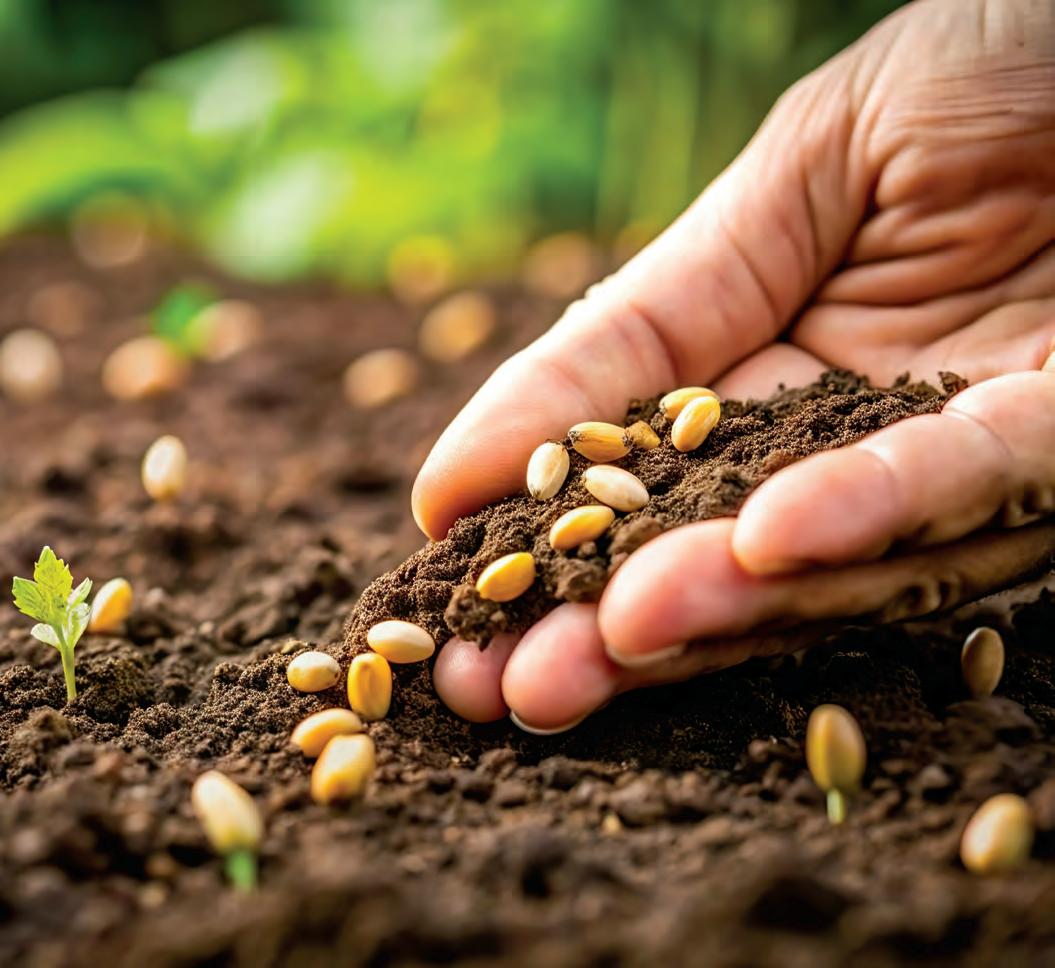
5 minute read
Here We Grow Again
Spring is just around the corner, and we all are itching to get our hands dirty — but starting too early is worse than starting too late
BY ROBIN SWEETSER / PHOTOS BY RAWPIXEL
It is tempting to get outside on a nice day and start digging as soon as the ground has thawed, but don’t. Never step in or work wet soil; it compacts easily, ruining its structure. To tell if it is ready, take the Cake Test:
• Try to squeeze a handful of soil into a ball.
• If it crumbles easily (like cake crumbs) it is good to go.
• If it stays in a ball, wait a few more days.
Soil is the Key
Old Farmer’s Almanac Digital Editor and Master Gardener Catherine Boeckmann reminds us of the importance of getting a proper soil test. “This will be your guide. It will determine what your soil is lacking and how to improve it.” Find more info at extension.unh.edu/resource/soil-testing-forms.
• Soil needs to drain well and have good texture – not heavy clay or too much sand.
• Depth – not too rocky or on a ledge. Roots need to be able to spread out and down at least 12 inches.
• Compost improves all types of soil by adding organic matter.
What to Grow
Grow what you eat! Don’t waste time, space and effort on things that are difficult to grow or nobody in your family likes. To save more money on your grocery bill, plant expensive, hard-to-find, or unique items that you use regularly. Herbs take up little room but make a meal special. Organic food can be pricey to buy but is not any harder to grow. Boeckmann’s list of vegetables that are easy-to-grow from seed include peas, beans, radishes, cukes, squash, lettuce and other greens.
Get your Seeds
If purchasing online, get your order in now. The good stuff goes fast. Split packs with a gardening friend or make an order together to save on shipping costs. (Baker Creek has free shipping.) Better yet, buy local.
Start Small
Don’t go overboard! A 10 x 10 plot or a couple of 4 x 8 raised beds can yield a lot of food while being easy to maintain. Boeckmann offers this beginner’s tip: “Most of us don’t want all of our harvest to appear at the same time. How much lettuce can you eat? Spread out the harvest by staggering your plantings. For lettuce, sow every few weeks. After you have harvested a crop, use that nice warmed-up space to plant more seeds and keep the harvest coming!”
Write It Down
Draw up a plot plan or use an online garden planner. Save from year to year to help with next year’s rotation.
Where to Grow
If you are starting from scratch, look for a site that is:
• Close to the house and has access to water.
• Sunny – 6-8 hours is considered full sun. If you only have half-day sun, you can still successfully grow greens, root crops, peas, potatoes, and brassicas.
• Not too windy or in a frost pocket.
• Orient beds to run from east to west when possible.
• On a hill, go across the slope to keep seeds and plants from washing downhill in a heavy rain.
When to Start
Timing is everything when you have a short growing season. Resist the urge to start your seeds too soon. Indoor plants will be leggy and stressed and suffer a greater setback when finally planted out. Seeds will sit and sulk, and many will rot.
• Read your seed packets. They often tell you when to start your seeds, indoors and out.
• Wait for the soil to warm up even if the seed packet says they can be planted as soon as the soil can be worked.
• Soil temps below 40 degrees are not conducive to germination, even for cool weather plants.
• Invest in a soil thermometer. Take soil temp at 9 a.m. for a week and average it.
Use 50 degrees as a minimum for planting those cold weather crops.
• Follow nature’s lead and look at conditions around you. When the forsythia blooms it is usually safe to plant your peas, but wait for the apple trees to bloom before planting beans. The Old Farmer’s Almanac has more examples of phenology.
• Use an online seed-starting calculator. Just plug in your zip code or last frost date.
Speaking of last frost date – according to the Old Farmer’s Almanac, it is May15 for Concord, but you know best the conditions at your house. I would love to push the season but that seems early for my garden so I am using May 25 as my estimated safeto-plant date.
Let There Be Light
If you decide to try growing your own transplants indoors, first invest in lighting. A sunny windowsill is not going to give you strong, stocky plants. The rule of thumb for growing sturdy transplants is to germinate the seeds in warmth and darkness, and as soon as they pop up, switch them to a cool bright spot under lights. Plants to start indoors include tomatoes, peppers, eggplant, brassicas, herbs, and many flowers.
We have grown excellent seedlings under cheap fluorescent shop lights for years, but leaving them on for the required 16 hours will impact your electric bill. Last year, I gave an LED grow light a try. The plants thrived under the weirdly colored light, and the electric bill hardly registered a blip!










